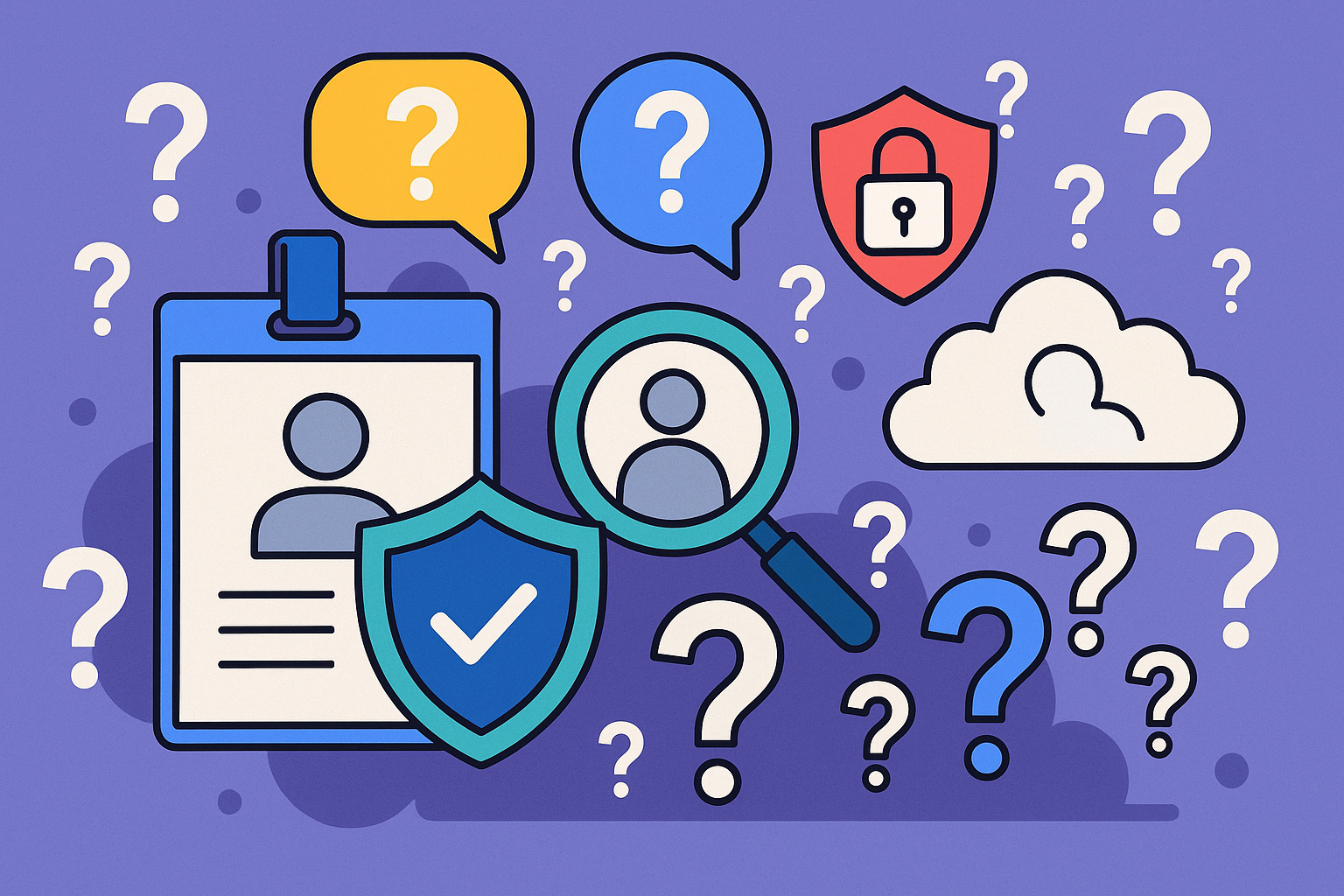
15 Questions Everyone Asks About Identity Threat Detection and Response(ITDR)

Hear Ye, Hear Ye
Subscribe to Cloud Chronicles for the latest in cloud security!
Identity has become the new battleground in cybersecurity. With over 90% of breaches now involving compromised credentials, organizations are scrambling to understand how to protect their identity infrastructure. Identity Threat Detection and Response (ITDR) has emerged as the answer, but confusion still reigns about what it actually does and how it fits into the broader security landscape.
This guide tackles the 15 most pressing questions about ITDR, providing the clarity security teams need to make informed decisions about protecting their identity perimeter.
1. What is ITDR, and how is it different from EDR, XDR, PAM, and IGA solutions?
ITDR (Identity Threat Detection and Response) is a security category focused specifically on detecting and responding to identity-based threats in real-time. Unlike other security solutions, ITDR monitors identity behaviors across all systems to catch attackers using legitimate credentials.
Here's how ITDR differs from other solutions:
| Security Solution | Primary Focus | What It Monitors | Response Type | Example Use Case |
|---|---|---|---|---|
| ITDR | Identity threats | User behaviors, authentication patterns, privilege usage | Automated identity-specific responses | Detecting compromised service accounts |
| EDR | Endpoint threats | Files, processes, network connections on devices | Endpoint isolation, process termination | Stopping malware execution |
| XDR | Correlated threats | Multiple security layers (endpoint, network, cloud) | Coordinated cross-platform response | Complex attack chain detection |
| PAM | Access control | Privileged account usage and sessions | Session recording, access approval | Managing admin access to servers |
| IGA | Identity lifecycle | Account creation, permissions, certifications | Workflow automation | Employee onboarding/offboarding |
The key distinction is that ITDR assumes identities will be compromised and focuses on detecting when that happens, while PAM and IGA try to prevent compromise through better governance and control.
2. Why is ITDR important in a Zero-Trust architecture?
Zero trust operates on "never trust, always verify" - but what happens after verification? That's where ITDR becomes critical. In zero-trust environments, ITDR provides continuous verification by monitoring what identities do after they're authenticated.
Traditional perimeter security fails when attackers steal legitimate credentials. Zero trust reduces attack surface, but ITDR catches attackers who've already passed your verification checks. It monitors for suspicious patterns like accessing systems outside normal hours, unusual data access patterns, or impossible travel scenarios.
Without ITDR, zero trust is like having a bouncer who checks IDs at the door but never watches what people do inside. ITDR provides that inside surveillance, detecting when verified identities start behaving maliciously.
3. How does ITDR help with identity-based attacks like credential stuffing or lateral movement?
ITDR creates behavioral baselines for every identity, then alerts on deviations that indicate attacks. For credential stuffing, ITDR detects patterns like rapid-fire login attempts across multiple systems or logins from unusual locations.
For lateral movement, ITDR tracks identity paths through your environment. When a user account suddenly accesses systems it's never touched before, or when service accounts start interactive sessions, ITDR flags these anomalies.

The real power comes from ITDR's ability to connect seemingly unrelated events. A failed login attempt might seem benign, but when correlated with a subsequent successful login from a different location and immediate access to sensitive systems, ITDR recognizes the attack pattern and responds before damage occurs.
4. What's the best way to use ITDR for AD or Azure AD monitoring?
Effective AD/Azure AD monitoring with ITDR requires watching both the control plane and data plane. Start by establishing baselines for normal administrative activities, then monitor for deviations.
🏢 Active Directory Monitoring
☁️ Azure AD Monitoring
The key is correlating activities across both environments. Attackers often exploit trust relationships between on-premises AD and Azure AD. ITDR should provide unified visibility across hybrid environments.
5. How do I integrate ITDR into my existing SIEM or SOAR stack?
ITDR integration follows a hub-and-spoke model where ITDR acts as a specialized detection engine feeding enriched identity context to your SIEM/SOAR platforms.
Webhook Support
ArcSight CEF
IOC Distribution
Sentinel/Chronicle
Event Deduplication
Schema Mapping
Batch & Stream Processing
ML Model Execution
Correlation Engine
Risk Scoring Algorithm
Context Enrichment
API Responses
Event Forwarding
Most ITDR solutions provide:
- REST APIs for bidirectional communication
- Pre-built connectors for major SIEM platforms
- Webhook support for real-time alerting
- STIX/TAXII threat intelligence sharing
Start with high-fidelity alerts to avoid SIEM alert fatigue. Focus on identity-specific detections your SIEM can't generate alone, like cross-platform identity correlation or behavioral anomalies requiring identity context.
6. Can ITDR detect service account misuse or orphaned identities?
Service accounts and orphaned identities represent some of the highest-risk vulnerabilities in any organization. These accounts often have elevated privileges, never expire, and lack the behavioral patterns of human users that traditional security tools rely on for detection.
ITDR approaches service account protection differently than human account monitoring. Since service accounts should exhibit highly predictable behavior, any deviation becomes immediately suspicious. The platform baselines normal service account activity: which systems they access, when they authenticate, and what actions they perform. When a service account suddenly starts interactive logins or accesses unusual resources, ITDR raises alerts.
Orphaned identity detection requires a different approach. ITDR continuously scans identity repositories and correlates with HR systems to identify accounts that no longer have valid owners. These zombie accounts might belong to former employees, contractors whose engagements ended, or old service accounts from decommissioned applications. The platform flags these accounts for review and can automatically disable them based on policy.
The challenge multiplies in organizations with thousands of service accounts and complex employee turnover. ITDR addresses this through automated discovery and classification. Machine learning algorithms distinguish between human and service accounts based on behavior patterns, while integration with HR systems ensures timely detection of accounts that should be deactivated.
For deeper insights into securing non-human identities including service accounts, API keys, and machine identities across your environment, check out our comprehensive guide to Non-Human Identity Security.
7. How does ITDR use behavioral analytics or UEBA?
ITDR employs machine learning to build behavioral profiles for every identity. Unlike generic UEBA solutions, ITDR's models are purpose-built for identity behaviors across authentication, authorization, and access patterns.
The behavioral engine analyzes:
| Temporal Patterns | When identities typically authenticate - analyzing login times, frequency patterns, and authentication schedules to establish normal working hours and detect off-hours access |
| Geographic Patterns | Where users normally connect from - tracking location-based access patterns, identifying impossible travel scenarios, and detecting connections from high-risk countries |
| Access Patterns | Which resources identities typically use - monitoring application usage, file access patterns, data volume transfers, and system interactions to baseline normal behavior |
| Peer Analysis | How similar roles behave - comparing user behavior against others with similar job functions, access privileges, and organizational roles to identify outliers |
| Sequential Patterns | Normal workflow progressions - understanding typical task sequences, application access order, and identifying deviations in established user workflows |
When behaviors deviate significantly from established baselines, ITDR generates risk scores. Multiple small anomalies compound into high-risk alerts, catching sophisticated attacks that might slip past rule-based systems.
8. What kind of identity signals are most useful for ITDR platforms?
The most valuable identity signals provide context about authentication, authorization, and actual access behavior. Quality matters more than quantity - focus on signals that reveal intent and detect compromise.

Enrichment signals like threat intelligence on IPs, impossible travel detection, and peer group analysis transform raw logs into actionable insights.
9. How do I use ITDR for real-time response in a hybrid cloud setup?
Hybrid cloud environments multiply complexity exponentially. Data flows between on-premises systems and multiple cloud providers, identities span different platforms, and traditional security boundaries dissolve. ITDR must adapt to this reality.

Real-time response in hybrid environments requires ITDR to act as an identity control plane across all platforms. Deploy collectors in each environment (on-premises, AWS, Azure, GCP) feeding into a centralized ITDR platform.
Configure automated responses for high-confidence detections: disable accounts, force re-authentication, or trigger step-up authentication. For medium-confidence alerts, queue for analyst review while collecting additional context.
10. How does ITDR tie into CIEM (Cloud Infrastructure Entitlement Management)?
ITDR and CIEM are complementary technologies that together provide complete identity security. CIEM focuses on preventing excessive permissions (the "what could happen"), while ITDR detects actual misuse (the "what is happening").
Integration Points:
- CIEM identifies over-privileged identities → ITDR watches them more closely
- ITDR detects privilege abuse → CIEM helps remediate permissions
- CIEM provides entitlement context → ITDR uses it for better detection
- Both feed identity risk scores for comprehensive posture management
Together, they enable "Continuous Adaptive Risk and Trust Assessment" (CARTA) for identities. CIEM reduces attack surface while ITDR catches attacks that exploit remaining permissions.
For organizations with significant cloud footprints, this integration is non-negotiable. Cloud environments' dynamic nature means permissions change constantly. Static compliance checks can't keep pace. The combination of CIEM's preventive controls and ITDR's detective capabilities provides the comprehensive coverage needed for cloud security.
To discover how to build a comprehensive identity security posture management strategy that unifies prevention, detection, and response capabilities, read our complete ISPM framework guide.
11. What criteria should we use to select the right ITDR solution for our organization?
Selecting an ITDR solution requires balancing technical capabilities with organizational realities. The best solution on paper might fail if it doesn't align with your environment, team skills, and security maturity.

Start with coverage assessment. Your ITDR solution must support all identity providers in your environment. Partial coverage creates dangerous blind spots that sophisticated attackers will exploit.
Detection capabilities separate good ITDR platforms from great ones. Look for solutions that go beyond simple rule matching to offer true behavioral analytics and machine learning. Test false positive rates during proof-of-concept evaluations – a solution that floods your team with alerts is worse than no solution at all. Evaluate how quickly the platform can detect various attack scenarios and whether it can identify novel threats not covered by predefined rules.
Integration capabilities determine operational success. The ITDR platform must integrate seamlessly with your existing security stack. This includes not just technical integration through APIs, but also workflow integration that matches your team's processes. If your SOC uses ServiceNow for ticket management, ensure the ITDR solution can create and update tickets automatically.
Consider the total cost of ownership beyond licensing fees. Factor in deployment complexity, ongoing management requirements, and the learning curve for your team. A slightly more expensive solution that requires less operational overhead might deliver better value than a cheaper alternative that demands constant attention.
12. How do we measure the effectiveness of an ITDR deployment?
Measuring ITDR effectiveness requires moving beyond vanity metrics to indicators that demonstrate real security value. The goal isn't to generate impressive-looking dashboards but to prove that ITDR reduces identity-related risk. Establish baselines before deployment to demonstrate improvement.
| Metric Category | What to Measure | Target Benchmarks |
|---|---|---|
| Detection | Mean time to detect (MTTD) | <24 hours → <1 hour |
| Coverage | % of identities monitored | >95% of privileged, >80% of all |
| Accuracy | False positive rate | <5% for high-priority alerts |
| Response | Mean time to respond (MTTR) | <4 hours → <30 minutes |
| Prevention | Identity incidents prevented | 20-30% reduction in 6 months |
Track leading indicators like number of risky behaviors detected and remediated before they become incidents. Document near-misses where ITDR caught attacks early. Calculate cost avoidance by comparing potential breach costs to ITDR investment.
13. What are the best practices for deploying ITDR?
Successful ITDR deployment follows a phased approach that builds visibility, detection, and response capabilities incrementally.
The phased approach minimizes risk while maximizing value. Foundation establishes visibility without disrupting operations, allowing you to understand normal identity behaviors before enabling detection. Detection Tuning prevents alert fatigue by gradually introducing rules based on real baseline data. Response Automation builds trust through measured escalation, starting with safe actions before implementing more aggressive containment. Optimization ensures your ITDR investment continues delivering value as your environment evolves and threat landscapes shift.
Training transforms ITDR from a tool into a capability. Ensure SOC analysts understand identity threats and how ITDR detects them. Create runbooks for common scenarios and practice response procedures. Consider appointing an identity security champion who specializes in ITDR operations and can mentor other team members.
14. How much does ITDR typically cost and how is it licensed?
ITDR pricing reflects the critical nature of identity security but varies significantly based on deployment model and organizational needs. Understanding pricing models helps budget appropriately and avoid surprise costs.
Most vendors offer three primary licensing models. Per-identity pricing, Per-user pricing, and Enterprise platform licensing.
Per-Identity
Charges for each monitored identity in your environment
- All identity types covered
- Human identities
- Service accounts
- Machine identities
Per-User
Charges for each human user protected
- Human identities
- Associated service accounts
- User-linked applications
- Personal devices
Enterprise Platform
Flat platform fee that scales with organization size
- All-inclusive features
- Unlimited identities within tiers
- Advanced analytics
- Premium support
Hidden costs often surprise buyers. Professional services for initial deployment can add 20-30% to first-year costs. Ongoing management might require dedicated staff time or managed service providers. Training and certification costs ensure your team can effectively use the platform. Infrastructure requirements, especially for on-premises deployments, add to the total cost.
Most organizations see positive ROI within 6-12 months through reduced incident costs and improved efficiency. Factor in cost avoidance from prevented breaches when building your business case.
15. How do we develop and test an incident response plan that includes ITDR?
ITDR transforms incident response by providing early warning and automated containment for identity attacks. Build your plan around ITDR's unique capabilities while addressing identity-specific threats.
Map Identity-Specific Incident Types:
Different identity attacks require different responses. Account for variations like external credential theft, insider threats, service account abuse, and supply chain attacks. Define severity levels based on the compromised identity's privilege level and access scope.
ITDR-Integrated Response Workflow:
ITDR INCIDENT RESPONSE WORKFLOW
- Identify threat detected
- Risk prioritization
- Ticket creation
- Risk score evaluation
- Context enrichment
- Initial containment
- Validate detection
- Scope assessment
- Determine response
- Containment actions
- Evidence collection
- Communication
- Restore access
- Root cause analysis
- Process improvement
Balance Speed with Accuracy:
Response procedures must prevent lateral movement while avoiding business disruption from false positives. Build escalation procedures matching response aggressiveness to threat confidence levels:
- Critical (95%+ confidence): Automated containment
- High (80-95%): Alert SOC, prepare containment
- Medium (60-80%): Investigation before action
- Low (<60%): Monitor and gather context
Testing Your Plan:
Conduct monthly tabletop exercises using real ITDR alerts. Run quarterly purple team exercises targeting identities. Test automated responses during maintenance windows. Track metrics for both successful containment and false positive rates.
CONCLUSION
The questions covered in this guide provide a roadmap for understanding and implementing ITDR effectively. Success requires more than just deploying technology. It demands understanding your identity landscape, integrating with existing security tools, training your team, and continuously improving based on real-world experience.
Organizations that master ITDR gain a significant advantage against modern threats. They detect compromises faster, respond more effectively, and maintain visibility across increasingly complex identity infrastructures. In a world where identity-based attacks show no signs of slowing, ITDR has evolved from a nice-to-have to an essential component of enterprise security.
The journey to effective ITDR starts with asking the right questions. Now that you have the answers, it's time to take action and strengthen your identity security posture before attackers exploit the gaps.



.png)






.png?width=767&name=Looking%20at%20AI%20Security%20Through%20the%20Identity%20Lens%20(1).png)
